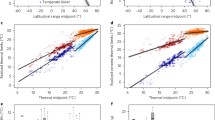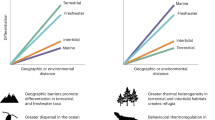Abstract
Rear (warm) edge populations are often considered more susceptible to warming than central (cool) populations because of the warmer ambient temperatures they experience, but this overlooks the potential for local variation in thermal tolerances. Here we provide conceptual models illustrating how sensitivity to warming is affected throughout a species’ geographical range for locally adapted and non-adapted populations. We test these models for a range-contracting seaweed using observations from a marine heatwave and a 12-month experiment, translocating seaweeds among central, present and historic range edge locations. Growth, reproductive development and survivorship display different temperature thresholds among central and rear-edge populations, but share a 2.5 °C anomaly threshold. Range contraction, therefore, reflects variation in local anomalies rather than differences in absolute temperatures. This demonstrates that warming sensitivity can be similar throughout a species geographical range and highlights the importance of incorporating local adaptation and acclimatization into climate change vulnerability assessments.
Similar content being viewed by others
Introduction
Climate change is altering species distributions across the globe1,2. A pressing challenge for climate change science is, therefore, to understand the sensitivity of organisms to the changing environment, which, given the global scale of the problem, ultimately requires extrapolation of local scale biological knowledge to broader spatial scales. Predicting species range shifts through species distribution modelling and by relating measured thermal-tolerance limits to species distributions has received a large research emphasis in recent years3,4,5. However, much of this work relies on thermal-tolerance estimates from a single climatic location3,4,5, and implicitly assumes conspecific populations living under different thermal regimes share a common thermal-tolerance breadth (that is, no local adaptation or acclimatization; Fig. 1a). This paradigm has a long history in ecology and biogeography6,7, and in the context of temperature thresholds implies that rear-edge (that is, low latitude and warm) populations have smaller thermal-safety margins (defined herein as the temperature buffer between an organisms upper thermal-tolerance limit and the maximum ambient temperatures it experiences) than central populations, making them more vulnerable to perturbation and species range contractions6 (Fig. 1a).
Distance between the solid line and the edge of the dashed box represents the thermal-safety margin. The three solid lines per model represent the variation in climatic ranges throughout a species geographical range. Thermal-safety margins are influenced by whether there is (a) no local adaptation/acclimatization or (b) local adaptation/acclimatization in the upper thermal-tolerance threshold. Models are not mutually exclusive. (a) Experienced climatic ranges differ in absolute temperatures but have similar variability among populations. Thermal-tolerance breadth is the same, but thermal-safety margins decrease towards rear-edge populations. (b) Same conditions as a, but thermal-tolerance breadth changes with range position and thermal-safety margins remain constant among populations.
Along thermal gradients, however, selection pressure from the environment can lead to local adaptation and acclimatization of thermal-tolerance limits among populations8,9,10. Local adaptation can occur both when the spatial scale of the environmental gradient exceeds the dispersal distance of the organism9, and in areas of higher gene flow where post-settlement selection processes (that is, balanced polymorphism) can structure local tolerance limits9,11. Phenotypic acclimatization can also result in distinct thermal-tolerance limits among populations living under different climatic conditions, which can persist within a population for single-to-multiple generations after conditions change12,13. In the context of climate change and climate variability, both these processes imply that the absolute temperature threshold of a rear-edge population might be higher than that of the central population. Consequently, both rear-edge and central populations may have similar thermal-safety margins and sensitivity to climate impacts (Fig. 1b). Despite increasing evidence for the importance of local adaptation and acclimatization in multiple taxa9,10,14, its implications for differences in vulnerability among conspecific populations living under different climatic regimes have not been integrated into a spatially explicit framework of species sensitivity to climate change (but see refs 15, 16, Supplementary Fig. 1).
Here we apply ‘locally adapted’ and ‘non-adapted’ models of warming sensitivity to test whether a warm range edge (RE) population undergoing range contraction is indeed more vulnerable to warming and extreme events than central populations living under cooler climatic conditions. Specifically, we observed whether thermal-safety margins varied among populations, by assessing the absolute temperature and the maximum thermal-stress anomaly at which biological processes (for example, growth and reproduction) ceased to function. Thermal-stress anomalies (herein called stress anomalies) were defined as temperatures that exceed the climatologically (long-term average) warmest day of the year17, which in the context of the translocated seaweeds meant that temperatures from the recipient locations were compared to long-term averages from source locations. If populations do not have locally adapted thermal limits (that is, Fig. 1a), thermal-safety margins would differ throughout a species range and we would expect responses to high temperatures among populations to be best explained by variation in absolute maximum temperature. By contrast, if populations have locally adapted thermal limits, thermal-safety margins would remain similar throughout a species range and we would expect responses to high temperatures among populations to be better explained by stress anomalies, rather than the absolute temperature. Our results demonstrate that thermal-safety margins are remarkably similar for a habitat-forming seaweed from central and rear-edge populations, highlighting that conspecific populations can be equally sensitive to warming throughout a species geographical range.
Results
Regional climatic conditions during heatwave and experiment
During Austral summer of 2011, an extreme marine heatwave caused anomalous ocean temperatures (that is, temperatures exceeding anything recorded in the past 140 years) across 1,000 km of the west coast of Australia’s Great Southern Reef18,Full size image
Tissue health
The decline in growth and reproductive development under high-stress anomalies coincided with an increase in putative disease symptoms and epiphytic fouling (Figs 3e and 4). Tissue health was significantly higher under low-stress anomalies, with 70–100% of thalli remaining free from disease symptoms and epiphytes compared with <50% of healthy tissue on thalli, where stress anomalies exceeded 2.5 °C (Fig. 3e, Table 2). In contrast, tissue health displayed no response to differences in the maximum temperatures (Fig. 3f, Table 2).






